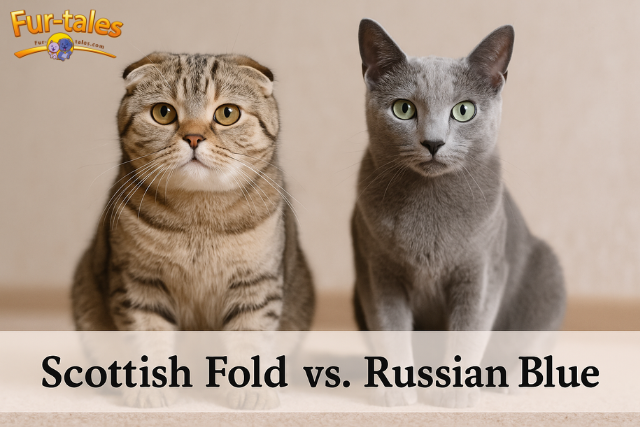
Scottish Fold vs. Russian Blue: Calm Companions for Cozy Homes
If your idea of the perfect evening includes a soft blanket, a cup of tea, and a cuddly feline curled up beside you, then you’re not alone. For many pet lovers, calm, affectionate, and easygoing cats are the ideal companions. And when it comes to low-key feline friends, two breeds often rise to the top: the Scottish Fold and the Russian Blue.
Both breeds are adored for their gentle demeanor and quiet personalities, making them excellent choices for families, singles, and seniors alike. But how do you decide which cat is right for your lifestyle? In this side-by-side comparison, we’ll explore everything from personality and grooming needs to health considerations and behavior—so you can choose your perfect calm companion.
Whether you’re looking for new pet owner tips or considering your first vet visit guide, this article is designed to help you make an informed, heartwarming choice.
Meet the Breeds
???? Scottish Fold
The Scottish Fold is instantly recognizable thanks to its signature folded ears, which bend forward and downward. This gives the breed a unique owl-like appearance that cat lovers find irresistibly cute. These cats are medium-sized, round-faced, and known for their sweet, cuddly temperament.
Quick Traits:
- Size: Medium (6–13 pounds)
- Coat: Short or long, plush
- Lifespan: 11–15 years
- Temperament: Affectionate, mellow, playful in short bursts
???? Russian Blue
The Russian Blue is the epitome of elegance, with a shimmering silvery-blue coat and striking green eyes. Reserved yet affectionate, this breed tends to form strong bonds with their human family while being a little shy around strangers.
Quick Traits:
- Size: Medium (7–12 pounds)
- Coat: Short, dense, double-layered
- Lifespan: 15–20 years
- Temperament: Gentle, loyal, quietly playful
Personality: Who’s the Better Lap Cat?
Both breeds are calm and companionable, but their personalities differ in subtle ways.
Scottish Fold Personality
Scottish Folds are famously easygoing. They enjoy lounging next to their humans, often in quirky positions like lying flat on their back or sitting upright (a pose affectionately called the “Buddha sit”).
They’re not hyperactive, but they do enjoy interactive play in short sessions. These cats adapt well to routines and are known for getting along with children and other pets.
???? New pet owner tip: Scottish Folds can become quite attached, so they do best in homes where someone is around for most of the day.
Russian Blue Personality
Russian Blues are affectionate but more reserved. They may take longer to warm up to guests, but once bonded with their family, they become loyal companions who often follow their humans from room to room.
They are intelligent, independent, and generally prefer a quieter environment. If you’re looking for a peaceful cat that offers love without being clingy, a Russian Blue may be your match.
???? First vet visit guide tip: Russian Blues are naturally cautious. Keep their first vet trip low-stress with treats and a cozy carrier.
Grooming and Maintenance
Neither breed is high-maintenance, but their coats do require some attention.
Grooming a Scottish Fold
Whether short- or long-haired, Scottish Folds have soft, plush coats that benefit from weekly brushing to remove loose fur and reduce shedding. Long-haired types may need more frequent grooming to prevent matting.
Also, their folded ears should be checked regularly for wax buildup or infection—something unique to this breed.
Grooming a Russian Blue
Russian Blues have a double-layered coat that’s surprisingly easy to manage. Weekly brushing is enough to keep it soft and healthy. They don’t shed excessively and are often well-tolerated by people with mild allergies.
Their grooming needs are minimal, but they do appreciate a consistent routine.
Health and Lifespan
Good health starts with a pet health checklist, especially when choosing a breed with known genetic tendencies.
Scottish Fold Health Concerns
The same gene that causes their signature ear fold is linked to osteochondrodysplasia, a condition that affects cartilage and bone development. This can lead to painful joint problems in some cats.
Responsible breeders aim to reduce the risk, but it’s something to watch for. Always choose a breeder who screens for health conditions and offers vet documentation.
Common issues:
- Arthritis
- Ear infections (due to folded ears)
- Joint stiffness
???? Tip: Soft bedding and joint supplements may help older Scottish Folds feel more comfortable.
Russian Blue Health Concerns
Russian Blues are generally very healthy and long-lived. They are prone to very few breed-specific conditions but may be at risk for:
- Obesity (due to their love of routine and food)
- Bladder stones (less common but worth monitoring)
Routine vet care, a healthy diet, and regular activity will keep your Russian Blue thriving for many years.
Energy Levels and Playtime
While both breeds are calm, they do enjoy play—on their own terms.
Scottish Fold Activity
Scottish Folds love gentle playtime but are not hyper or demanding. They’ll chase a toy mouse or bat a feather wand for a few minutes and then return to napping. They enjoy toys that stimulate their curiosity but aren’t overly active.
Perfect for:
- Small apartments
- Families with children or seniors
- Cat parents who want a mellow companion
Russian Blue Activity
Russian Blues are a bit more agile and love climbing and perching. While they’re not hyper, they do appreciate puzzle toys and vertical spaces like cat trees or window perches.
Perfect for:
- Pet parents who enjoy intellectual play
- Quiet households
- Singles or couples with time to interact
Kid and Pet Friendliness
Both breeds can coexist beautifully with respectful children and other pets, but they differ slightly in social tolerance.
- Scottish Fold: Very tolerant, great with kids, calm around dogs and other cats.
- Russian Blue: More reserved, may take longer to warm up to others, but peaceful when introduced gradually.
Which Cat is Right for You?
| Trait | Scottish Fold | Russian Blue |
|---|---|---|
| Temperament | Affectionate, mellow | Gentle, reserved |
| Social Needs | High, loves attention | Moderate, prefers quiet time |
| Grooming Needs | Moderate | Low |
| Health Concerns | Moderate (joints, ears) | Low |
| Ideal Home Environment | Active families or homebodies | Quiet homes, introverts |
| Kid/Pet Compatibility | Very good | Good with slow intro |
FAQs: Scottish Fold vs. Russian Blue
Q: Are Scottish Folds good for first-time cat owners?
A: Yes, as long as you’re aware of their potential health concerns. They’re affectionate, easygoing, and adaptable to many lifestyles.
Q: Do Russian Blues get along with dogs?
A: Yes, with proper introductions. Russian Blues prefer calm, respectful dogs and will likely retreat rather than fight.
Q: Are Scottish Folds hypoallergenic?
A: No cat is truly hypoallergenic, but Scottish Folds do not produce unusually high allergens. Russian Blues, however, are known to be more tolerable for allergy sufferers.
Q: Which breed is more vocal?
A: Scottish Folds are generally quiet, but some can be chatty. Russian Blues tend to be even more reserved and soft-spoken.
Q: Should I get pet insurance for these breeds?
A: Yes. Especially for Scottish Folds, insurance can help cover potential joint or ear issues. It’s also helpful for covering routine care on your pet health checklist.
Image Designed Using Canva
